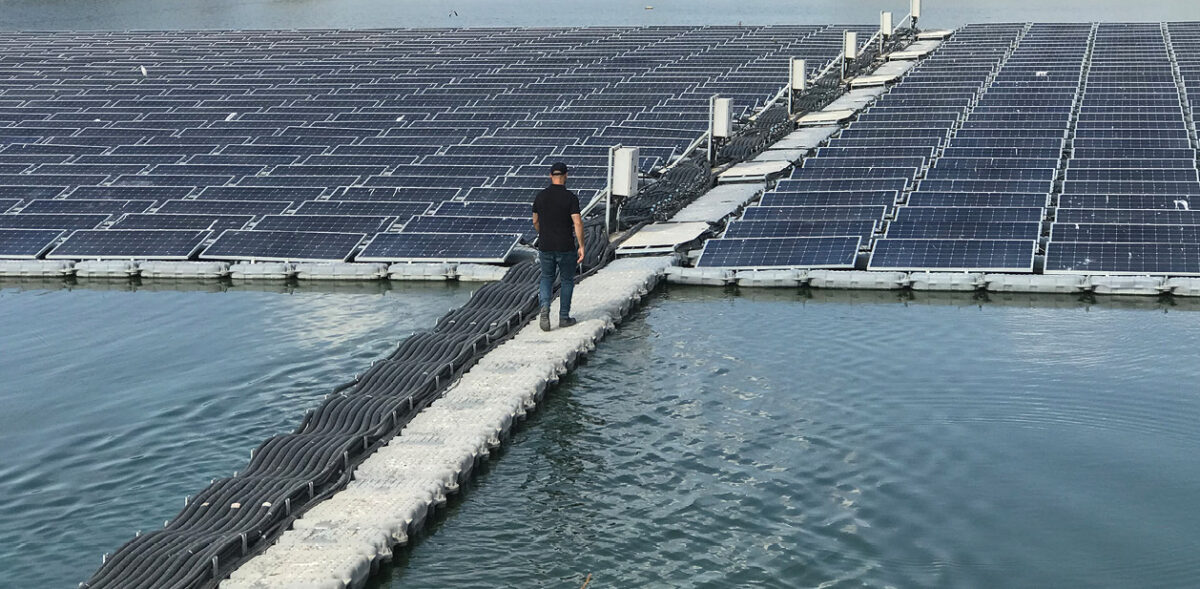A research team assessing a novel design heat sink as a way of reducing thermal degradation on floating photovoltaic systems (FPVs) at Port Said, Egypt, found that partially submerged angle perforating fins (PSAPF) were highly efficient at increasing heat dissipation from the systems.
In assessing the negative effects of heat on FPVs, the researchers found that “each 1-degree Celsius rise in operational temperature resulted in a 0.5% drop in Photovoltaic module electrical efficiency.”
To combat this problem, the group conducted experiments using two distinct submerged heat sink designs, one with perforated fins (PSAPFs) and one with solid fins (PSASFs). They assessed the thermal and electrical performance compared with a reference FPV array without cooling (FPV-R). The report specifies that the goal was “to identify the optimal productivity of the FPV module in terms of heat sink designs, module operating temperature, wind and water current speeds.”
With a surface water current of 0.3 m/s and wind of 5 m/s with a direction of 60 degrees, the researchers found that the use of PSAPFs resulted in a 28.11% increase in electrical efficiency and a 33.31% reduction in operating temperature compared to the FPV-R. The use of PSASFs resulted in a 22.82% increase in electrical efficiency and a 28.39% reduction in operating temperature compared to the FPV-R.
“The generated power of the FPV-PSASF and FPV-PSAPF modules enhanced by 18.14% and 22.77%, respectively, in comparison to the FPV-R module, achieving average values of 56.59 W and 58.81 W, respectively,” the group said, noting that all systems were operating under the same conditions.
The academics used two arrangements of aluminum-angle U-shape fin arrays that were each 900 mm long. Each array featured 12 angle fins, with 600 mm on the backside of the FPV exposed to ambient air, and the other 300 mm submerged in a large water basin that simulated the actual body of water. The fins expanded the heat transfer surface area of the FPVs, removing heat via convection.
Popular content
The researchers chose aluminum as the fin array material “due to its good thermal conductivity, lightweight, and low cost.” Researchers bonded the fins to a flat aluminum plate before using resin to affix them to the backside of the modules under investigation. This method enabled easy installation or removal of the fin arrangement.
According to the group, “The economic assessment revealed that the LCOE of the PSAPF-FPV module with the optimized condition decreased by 17.70% to 0.068 ($/kWh) while attaching the partially submerged angle solid fins PSASF reduced the LCOE by 12.50%, comparing to the referenced FPV module, to 0.072 ($/kWh).” The perforated fins not only provided better results than the solid fins, they also reduced the material fin weight by 15% in comparison.
The researchers’ conclusions appeared in “An innovative cooling technique for floating photovoltaic module: Adoption of partially submerged angle fins,” published in Energy Conversion and Management: X. The authors include members of the faculty from Port-Said University, as well as a researcher from Egypt’s Ministry of Electricity and Renewable Energy.
“Future studies will look at the quantified rates of water conserved as well as the overall reduction in evaporation. These, as well as other related cooling strategies, should be researched further in the future,” the authors concluded.
This content is protected by copyright and may not be reused. If you want to cooperate with us and would like to reuse some of our content, please contact: editors@pv-magazine.com.



While the performance gained is impressive the heating of the water is detrimental to the environment both to the global warming effects of increased evaporation and the wildlife living in the water.